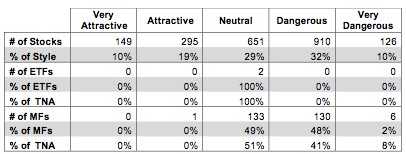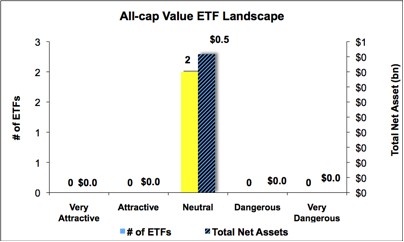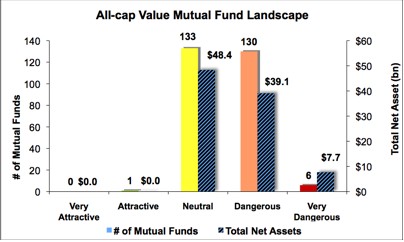The all-cap value style ranks seventh out of the twelve fund styles as detailed in my Style Rankings for ETFs and Mutual Funds report. It gets my Dangerous rating, which is based on aggregation of ratings of two ETFs and 270 mutual funds in the all-cap value style as of February 7th, 2013. Prior reports on the best & worst ETFs and mutual funds in every sector and style are here.
Figure 1 ranks from best to worst the two all-cap value ETFs and Figure 2 shows the five best and worst-rated all-cap value mutual funds. Not all all-cap value style ETFs and mutual funds are created the same. The number of holdings varies widely (from seven to 2028), which creates drastically different investment implications and ratings. The best ETFs and mutual funds allocate more value to Attractive-or-better-rated stocks than the worst, which allocate too much value to Neutral-or-worse-rated stocks.
To identify the best and avoid the worst ETFs and mutual funds within the all-cap value style, investors need a predictive rating based on (1) stocks ratings of the holdings and (2) the all-in expenses of each ETF and mutual fund. Investors need not rely on backward-looking ratings. My fund rating methodology is detailed here.
Investors should not buy any all-cap value ETFs or mutual funds because none get an Attractive-or-better rating. If you must have exposure to this style, you should buy a basket of Attractive-or-better rated stocks and avoid paying undeserved fund fees. Active management has a long history of not paying off.
Get my ratings on all ETFs and mutual funds in this style on my free mutual fund and ETF screener.
Figure 1: ETFs with the Best & Worst Ratings
Sources: New Constructs, LLC and company filings
Figure 2: Mutual Funds with the Best & Worst Ratings – Top 5
 * Best mutual funds exclude funds with TNAs less than $100 million for inadequate liquidity.
* Best mutual funds exclude funds with TNAs less than $100 million for inadequate liquidity.
Sources: New Constructs, LLC and company filings
Seven mutual funds are excluded from Figure 2 because their total net assets (TNA) are below $100 million and do not meet our liquidity standards.
iShares Russell 3000 Value (IWW) is my top-rated all-cap value ETF and Homestead Funds, Inc: Value Fund (HOVLX) is my top-rated all-cap value mutual fund. Both earn my Neutral rating.
First Trust Multi Cap Value AlphaDEX Fund (FAB) is my worst-rated all-cap value ETF and earns my Neutral rating. Fairholme Funds, Inc: Fairholme Fund (FAIRX) is my worst-rated all-cap value mutual fund and earns my Very Dangerous rating.
Figure 3 shows that 444 out of the 2131 stocks (over 29% of the market value) in all-cap value ETFs and mutual funds get an Attractive-or-better rating. However, none of the two all-cap value ETFs and only one of the 270 all-cap value mutual funds (less than 1% of total net assets) gets an Attractive-or-better rating.
The takeaways are: mutual fund managers allocate too much capital to low-quality stocks and all-cap value ETFs hold poor quality stocks. Investors should buy a basket of individual stocks instead and avoid paying undeserved fees.
Figure 3: All-cap Value Style Landscape For ETFs, Mutual Funds & Stocks
 Sources: New Constructs, LLC and company filings
Sources: New Constructs, LLC and company filings
As detailed in “Cheap Funds Dupe Investors”, the fund industry offers many cheap funds but very few funds with high-quality stocks, or with what I call good portfolio management.
Investors need to tread carefully when considering all-cap value ETFs and mutual funds, as no ETFs and only one mutual fund in the all-cap value style allocate enough value to Attractive-or-better-rated stocks to earn an Attractive rating. With all the quality stocks in this style, it is shame that ETF and mutual fund providers cannot offer investors better products.
Ford Motor Company (F) is one of my favorite stocks held by all-cap value ETFs and mutual funds and earns my Very Attractive rating. Ford’s return on invested capital (ROIC) is at 13% and has been rising since 2008. It grew after-tax profit (NOPAT) by 12% in 2011 following an astounding 926% growth in 2010. Last month it had its best ever January for passenger car sales in China, the world’s largest emerging market. Despite this impressive growth, Ford is valued at only ~$13.20/share, giving it a price to economic book value ratio of 0.5. This ratio implies that Ford’s NOPAT will permanently decline by half. It is hard to imagine this company experiencing such a drastic, permanent reversal in profitability.
Beam Inc. (BEAM) is one of my least favorite stocks held by all-cap value ETFs and mutual funds and earns my Very Dangerous rating. This spirits company’s NOPAT has declined by an average of 18% annually for the last four years. Its economic earnings for 2011 were ~2.40/share, which stands in marked contrast to its reported earnings per share of $5.80. Guess which of those two numbers has grabbed investors’ attention? These high reported earnings have driven BEAM’s share price up to ~$61.70. This valuation implies a 12% growth in NOPAT compounded annually over the next eight years. I think it is too risky to own BEAM and bet it will reverse course and achieve such significant profit growth.
Figures 4 and 5 show the rating landscape of all all-cap value ETFs and mutual funds.
My Style Rankings for ETFs and Mutual Funds report ranks all styles and highlights those that offer the best investments.
Figure 4: Separating the Best ETFs From the Worst Funds
 Sources: New Constructs, LLC and company filings
Sources: New Constructs, LLC and company filings
Figure 5: Separating the Best Mutual Funds From the Worst Funds
 Sources: New Constructs, LLC and company filings
Sources: New Constructs, LLC and company filings
Review my full list of ratings and rankings along with reports on all two ETFs and 270 mutual funds in the all-cap value style.
Sam McBride contributed to this report.
Disclosure: David Trainer owns F. David Trainer and Sam McBride receive no compensation to write about any specific stock, sector or theme.

